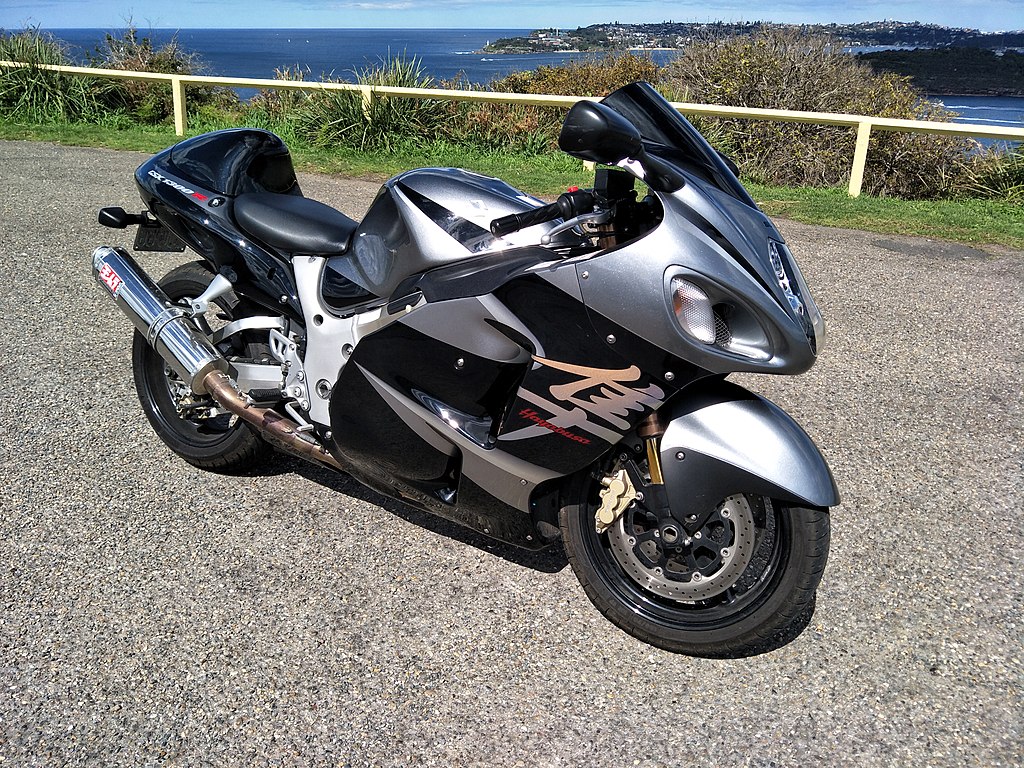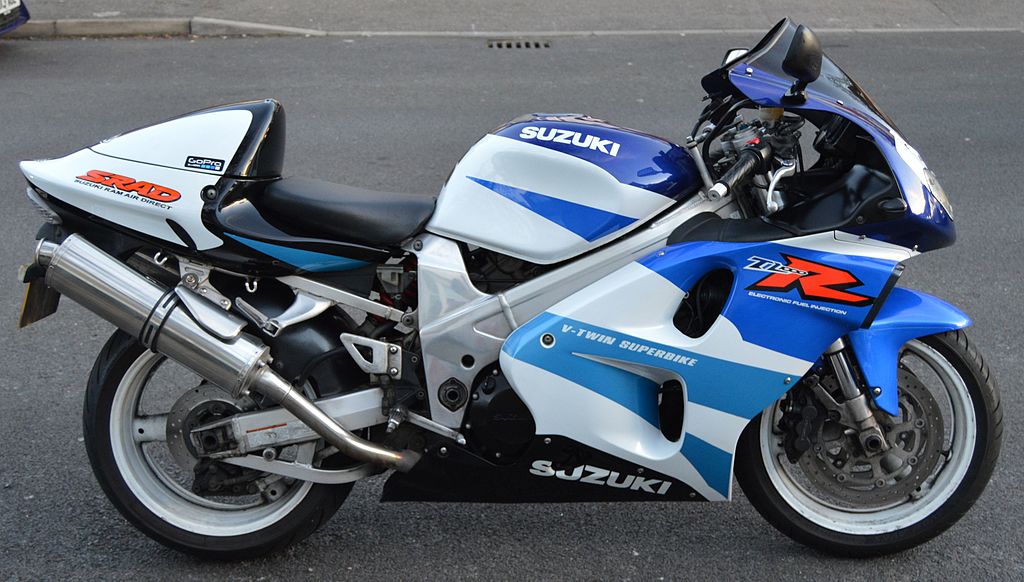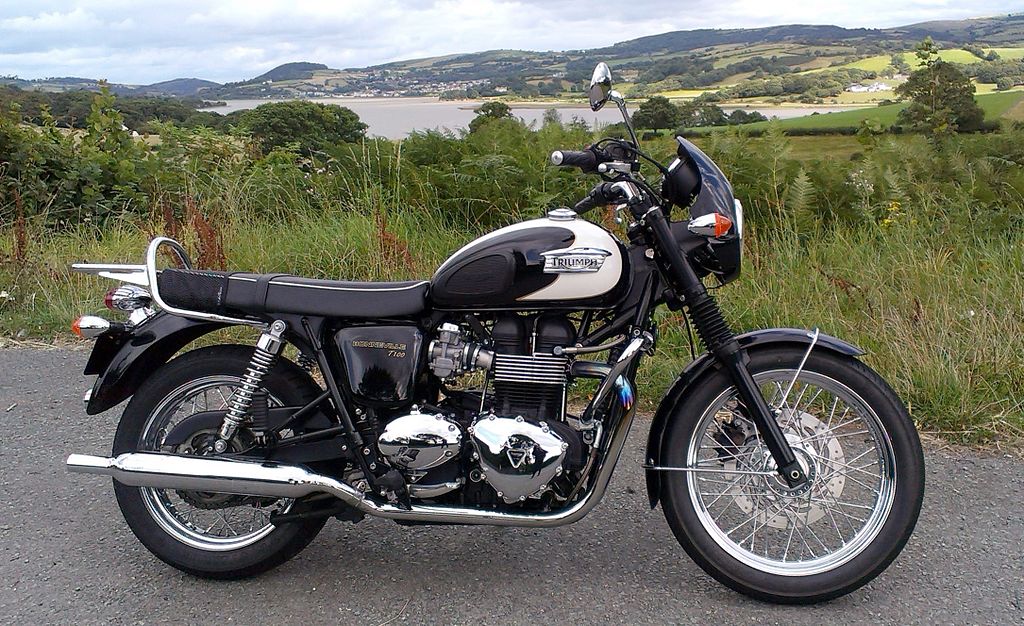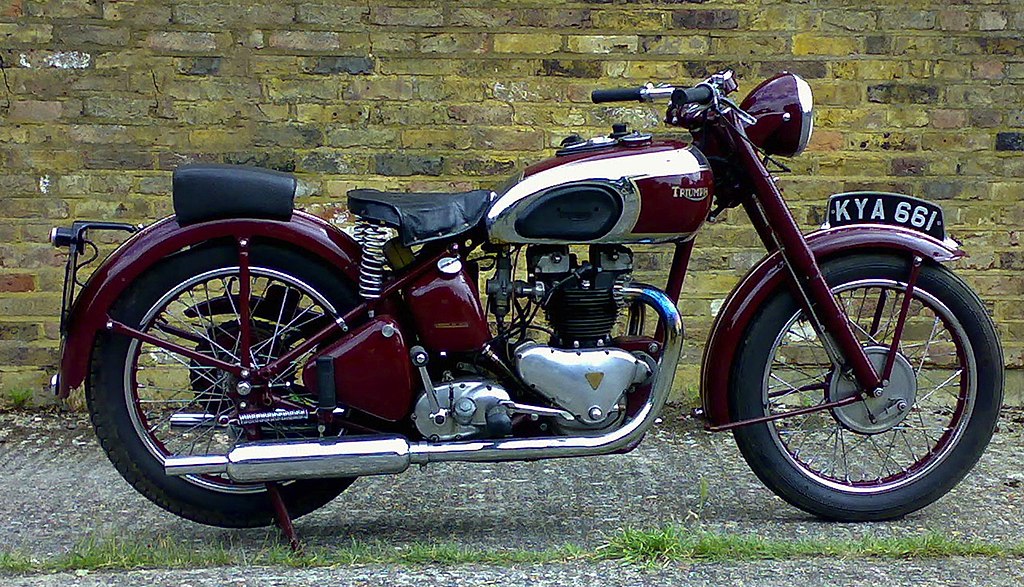
Here you can study for the exam. Look up keywords and learn definitions about all kind of subjects.
More subjects
The Norton Manx or Manx Norton is a British racing motorcycle that was made from 1947 to 1962 by Norton Motors Ltd. Norton had contested every Isle of Man TT race from the inaugural 1907 event through into the 1970s, a feat unrivalled by any other manufacturer, and the development and honing of the Manx racing motorcycle was another step in this racing achievement. New Manx Nortons, built to various specifications are still available to buy new, from various suppliers around the world. These should not be confused with Norton production motorcycles even though they suit different categories and definitions of Classic Motorcycle Racing and Historic Motorcycle Racing in different countries around the world. (Source: Wikipedia.org, CC BY-SA)
The Panther Model 120 was a British motorcycle made between 1959 and 1966 by Phelon & Moore. An enlarged Panther Model 100, the 120 had a reputation for being less reliable with a tendency for rapid clutch wear, problematical roller bearings and heavy oil consumption. As competitors produced modern designs, Panther ran into trouble obtaining supplies of Burman gearboxes and Lucas Magdynos, so production ceased in 1966 and the company was wound up. The Panther sloper engine designed by Granville Bradshaw remained unchanged for 25 years and the 650 cc 'heavyweight' had many of the Model 100 components. The increased capacity was achieved by boring out the Model 100 cylinder by 1 mm and increasing the stroke by 6 mm. As well as increased low speed torque this improved acceleration and top end cruising speed. (Source: Wikipedia.org, CC BY-SA)
The Royal Enfield Bullet was originally an overhead-valve single-cylinder four-stroke motorcycle made by Royal Enfield in Redditch, Worcestershire, now produced by Royal Enfield (India) at Chennai, Tamil Nadu, a company originally founded by Madras Motors to build Royal Enfield motorcycles under licence in India. The Royal Enfield Bullet has the longest unchanged production run of any motorcycle having remained continuously in production since 1948. The Bullet marque is even older, and has passed 75 years of continuous production. The Royal Enfield and Bullet names derive from the British company which had been a subcontractor to Royal Small Arms Factory in Enfield, London. (Source: Wikipedia.org, CC BY-SA)
The Suzuki GSX-R750 is a sports motorcycle made by Suzuki since 1984. It was introduced at the Cologne Motorcycle Show in October 1984 as a motorcycle of the GSX-R series for the 1985 model year. The air and oil-cooled models can be divided into the first-generation and the second-generation colloquially referred to as 'slabbies' and 'slingshots' respectively. The 1985-1987 models featured very flat bodies compared to modern sport-bikes, hence the term 'slab-sided'. 1988-1991 (1992 USA) models are sometimes referred to as slingshots because the carburetors introduced in 1988 were marketed as slingshot carburetors (slingshot describes the cross-section of the semi-flat slide carbs). (Source: Wikipedia.org, CC BY-SA)
The Suzuki GSX1300R Hayabusa is a sports motorcycle made by Suzuki since 1999. It immediately won acclaim as the world's fastest production motorcycle, with a top speed of 303 to 312 km/h (188 to 194 mph). In 1999, fears of a European regulatory backlash or import ban led to an informal agreement between the Japanese and European manufacturers to govern the top speed of their motorcycles at an arbitrary limit starting in late 2000. The media-reported value for the speed agreement in miles per hour was consistently 186 mph, while in kilometers per hour it varied from 299 to 303 km/h, which is typical given unit conversion rounding errors. This figure may also be affected by a number of external factors, as can the power and torque values. (Source: Wikipedia.org, CC BY-SA)
 © Wikimedia.org/Electronicboss5764, CC BY-SA
© Wikimedia.org/Electronicboss5764, CC BY-SA
The Suzuki RG500 'Gamma', a sport bike with a two-stroke engine, was produced by Suzuki for just two years between 1985 and 1987. The RG 'Gamma' 500 was directly based on the series of Suzuki RG Γ 500 Grand Prix motorcycles with almost identical features to the official two-stroke machines used by Italian world champion Franco Uncini during the 1984 season with the Gallina team. The RG Γ 500 won two consecutive Riders' Championships in the 500 cc class with Marco Lucchinelli in 1981 and Franco Uncini in 1982. Like its GP forebears, the road-going RG was powered by a naturally aspirated, rotary-valve inducted, twin crank square four two-stroke engine displacing some 498 cc. This engine employed thermostatically controlled liquid-cooling by means of a front-mounted radiator. (Source: Wikipedia.org, CC BY-SA)
The Suzuki TL1000R motorcycle was introduced in 1998 as Suzuki's 90° V-Twin Superbike. Production ended in 2003. The TL1000R is a full fairing racing-oriented version of Suzuki's popular TL1000S. The TL1000R was launched in 1998, one year after its sibling, the TL1000S. Unlike the TL-S, the TL-R was designed to compete in the World and American Superbike Championships, although it achieved only one race win before Suzuki pulled the plug on the TL racing program, in favor of returning to the lighter GSX-R750 as its Superbike entry. The TL-R took aim at Ducati's 916 both in the Superbike Championship and in consumer sales. The R shares basic engine architecture with the S but has special components including forged pistons, stronger connecting rods, and a much stiffer frame while retaining the motors 90° V-twin for perfect primary balance and had hybrid chain/gear driven cams. A traditional cam chain turned a gear that in turn rotated the cams. This hybrid design eased maintenance immensely and gave the motor additional aural character because of the gear whine. The engine tweaks given to the TL-R made it known for its very good top-end horsepower (as compared to most V-twins that make better bottom end power). The TL-R was offered in yellow, blue/white, black, and red. Suzuki stopped production of the TL1000S in 2001, and the TL1000R in 2003. (Source: Wikipedia.org, CC BY-SA)
 © Wikimedia.org/RubSub, CC BY-SA
© Wikimedia.org/RubSub, CC BY-SA
The Triumph Bonneville is a standard motorcycle featuring a parallel-twin four-stroke engine and manufactured in three generations over three separate production runs. The first two generations, by the defunct Triumph Engineering in Meriden, West Midlands, England, were 1959–1983 and 1985–1988. The third series, by Triumph Motorcycles in Hinckley, Leicestershire, began in 2001 and continues to the present as a completely new design that strongly resembles the original series. The name Bonneville derives from the famous Bonneville Salt Flats, Utah, USA where Triumph and others attempted to break the motorcycle speed records. (Source: Wikipedia.org, CC BY-SA)
 © Wikimedia.org/Hogyn Lleol, CC BY-SA
© Wikimedia.org/Hogyn Lleol, CC BY-SA
The Speed Twin 5T is a standard motorcycle that was made by Triumph at their Coventry, and later Meriden factories. Edward Turner, Triumph’s Chief Designer and Managing Director, launched the Triumph Speed Twin at the 1937 National Motorcycle Show. It was a 500 cc OHV vertical twin in a lightweight frame and the first truly successful British parallel twin, setting the standard for many twins to follow. After World War II the Speed Twin was responsible for the survival of Triumph, and several major British marques offered a 500 cc twin designed on similar lines to the Speed Twin. (Source: Wikipedia.org, CC BY-SA)
 © Wikimedia.org/London Motorcycle Museum, CC BY
© Wikimedia.org/London Motorcycle Museum, CC BY
The Velocette Venom was a 499 cc single-cylinder four-stroke British motorcycle made by Velocette at Hall Green in Birmingham. A total of 5,721 machines were produced between 1955 and 1970. In 1961 a factory-prepared faired Velocette Venom and a team of riders set the 24-hour world record at a speed of 100.05 mph (161.01 km/h) at the Autodrome de Linas-Montlhéry, a banked oval racetrack in France. It was the first motorcycle to average over 100 mph continuously for 24 hours and no 500cc or single-cylinder motorcycle has broken this record. In 1965, the Velocette Venom was further developed with a full racing kit to create the range-topping Velocette Thruxton, with a special cylinder head developed by American flat-track racers, and adapted by Velocette to create a new production racer. It was a very popular and successful clubman racer, winning the 1967 Isle of Man Production TT. The Thruxton became the most popular Velocette model, but could not save the Velocette company from bankruptcy in 1971. Poor trading conditions over a number of preceding years forced the company into voluntarily liquidation in 1971, with all the remaining stock and tools sold off to pay creditors. (Source: Wikipedia.org, CC BY-SA)
The Vincent Black Shadow is a British motorcycle designed and built at the Vincent works in Great North Road, Stevenage, Hertfordshire UK. Motorcycles produced by Vincent H·R·D at their factory in Stevenage, Hertfordshire, England were renowned for their design innovation, engineering excellence and high performance. Already advertising their existing 110 mph Rapide machine as 'The world's fastest production motorcycle', in February 1948 the distinctive Vincent Black Shadow was announced with a top speed of 125 mph. Built in three different Series over the course of its life, the line continued until 1955, after which the company stopped all motorcycle production. (Source: Wikipedia.org, CC BY-SA)
The Yamaha YZF-R1, or simply R1, is a 998 cc (60.9 cu in) sports motorcycle made by Yamaha. It was first released in 1998, undergoing significant updates in 2000, 2002, 2004, 2006, 2007, 2009, 2015, 2018 and 2020. Yamaha launched the YZF-R1 in 1998 after redesigning the Genesis engine to create a more compact engine by raising the gearbox input shaft and allowing the gearbox output shaft to be placed beneath it. This 'stacked gearbox' was followed by other manufacturers. Compacting the engine made it much shorter, allowing the wheelbase to be shortened as well and the center of gravity to be optimized. The swingarm could be made longer without compromising the overall wheelbase, which was a short 1,385 mm (54.5 in). Four 40 mm Keihin CV carburetors fed fuel to the engine. (Source: Wikipedia.org, CC BY-SA)
The Yamaha V-Max, (or VMAX) is a cruiser motorcycle produced by Yamaha from 1985 through 2020. Known for its 70° V4 engine, shaft drive, and distinctive styling, the V-Max was discontinued following the 2020 model year. Overall, the V-Max was 2,300 mm (91 in) long, 795 mm (31.3 in) wide, and 1,160 mm (46 in) high. The engine was a tuned version of the double overhead camshaft, four valve per cylinder, liquid-cooled V-4 from the Yamaha Venture. Along with other modifications to the engine, the compression ratio was raised to 10.5:1, and the V-Boost system was added. V-Boost is a system that opens butterfly valves in the intake manifold between the 1st and 2nd and between the 3rd and 4th cylinders starting from 5,750 rpm. The valves are opened gradually to match the rising engine speed with a signal provided by the ignition system. The valves are at the full open position at 8,000 rpm. A small black box sends a computed signal to a servo motor that pulls a wire to open the butterfly valves. The V-Boost system adds 10 percent to the top power rating of the base engine. (Source: Wikipedia.org, CC BY-SA)

Time for recess! Post a comment, ask a question or write a review. Feel free to let us know what you think!
look at the sign on the road to avoid accidents and horrible driving conditions
English Language Errors Question 48 You’re approaching a road narrowing, which traffic sign indicates you have give way? Neither. A and B. A. B. Question 27 How many pedals does a vehicle with manual gears have? 3 gears. 4 gears. 2 gears. 1 gear.
I received a 300$ ticket because I passed a police control of other cars/drivers on the right lane of a highway (the control was on the hard shoulder of the highway). Is it really true, that you have to change the lane in such cases? Thanks!
I am an American living in Italy. The Italian Drivers License theory test is the hardest test I have ever studied for and I am in my 70s have multiple degrees, multiple professional certifications. Have to take the Italian Drivers Theory test in Italian. No english. So many rules. More signs in small medieval Italian town I live in then in major US cities I have lived in. No Italian license no driving. No buying or renting a car. Test here was good, clean. Lots of tricky questions on many practice and real official tests. Thanks
Most problems are a result of higher than safe driving speeds. Please just slow down and be patient.
Question 121: Poor translation: Vehicles with polluted fluids prohibited Should be translated as: Vehicles with dangerous liquids prohibited
Question 83: Poor translation: Vehicles with polluted fluids prohibited Should be translated as: Vehicles with dangerous liquids prohibited
Want even more practice? Visit similar websites offering realistic practice driving knowledge tests. Visit us to see what sets our tests apart! https://dkttest.com/capital-territory/
More community